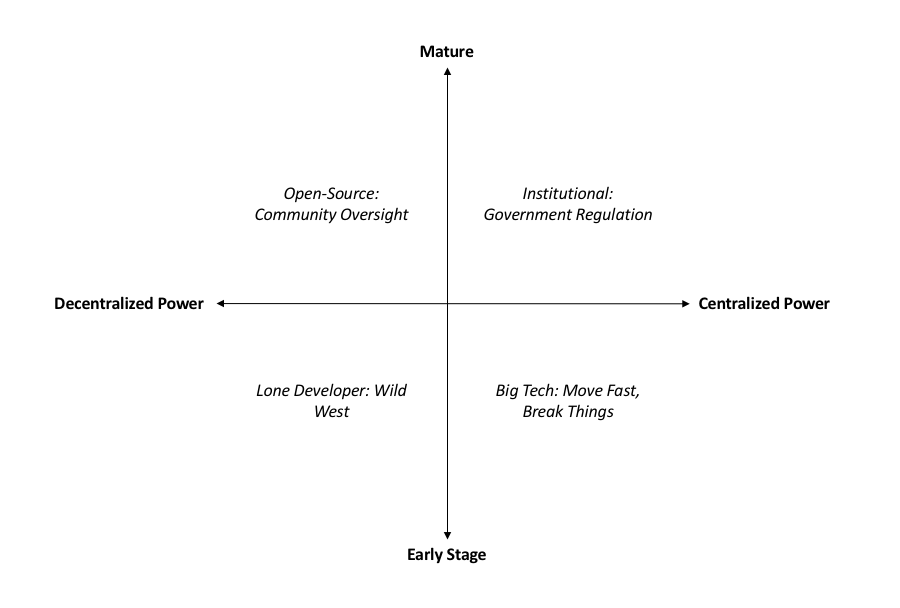Innovation follows a cyclical nature. The governance of technology, however, is shaped by humans — the ultimate decision makers in how technology is developed, deployed, and managed.
Today, after several decades of unfettered innovation, we are witnessing the outcomes of letting tech run its course. Unequivocally, the digital age has improved the lives of citizens around the globe by increasing access to services and information. However, it is also increasingly clear that the opportunities for evil are no less frequent than those that advance humanity forward. Ash Carter, former Secretary of Defense and director of the Harvard Kennedy School’s Belfer Center for Science and International Affairs, has said that “Disruptive scientific and technological progress is not inherently good or inherently evil. But its arc is for us to shape.”
So what has given us a collective moment of pause? The last century of technology was often developed by the few, for the many. Specific actors, privy to the necessary resources and expertise, wielded the power to experiment with cutting-edge innovation. In the 1990s and early 2000s, tech optimism championed the reversal of this trend: the so-called democratization of technology. This new era promised greater public accessibility and an opportunity to tailor technology to one’s individual experiences and problems. In short, technology was becoming decentralized and it promised to return power back to the people.
In the last few decades, many technologies have indeed become more accessible. But, in reality, some of the progress on the path to democratizing tech has been overshadowed by new challenges in governance. The sheer expansion of access has, in many cases, made it difficult to set parameters around the impacts that technologies have on diverse communities, sometimes with conflicting interests and incentives. For instance, the ubiquity of artificial intelligence, and its presence in industries ranging from healthcare to gaming, complicates the process of setting even the most fundamental ground rules.
Decentralized development, made possible by diminishing cost barriers, deregulation, and more accessible scientific knowledge, has also led to the rise of commercial tech firms. As Margaret O’Mara describes it in her recent book The Code, big tech has become “the engine room of the American economy.” In the process of dominating financial markets, the private tech sector has disproportionately surged ahead in the financing and investment of scientific research and development. Meanwhile, the government’s stake in basic and applied science research has slipped to historic lows. And accordingly, the public sector is gradually losing a certain degree of power and its ability to govern along the way.
The dispersion of power is leading to a displacement of public function. The traditional role of governing a particular technology’s common interest or public purpose has become increasingly difficult for government to fulfill. Historically, the development of nuclear arms or the global positioning system (GPS) — both products of the military-industrial complex — remained in the centralized quadrants, on the right-hand side, moving upward from early-stage development all the way through to maturity. New technologies, such as gene drives or small satellites, now begin in the decentralized, early-stage quadrant and increasingly mature over time. The horizontal direction of their maturity, however, is much less clear.

The difference between these two starting points not only introduces a greater number of vulnerable infliction points to public purpose, but it requires an immense effort to bring a decentralized technology to comply with acceptable norms, oversight, or regulation. Where a technology begins defines how we collaborate across business, government, academia, and the non-profit sector, to protect the values of privacy, inclusion, transparency and accountability, safety, and security to the ends of a fair and just society. And how it matures is a testament to our progress.
Decentralized power is now the new norm. Each era of technological advancement has required the collective action of society to put forward its long-standing values to govern newfound technologies and their consequences. The future of today’s technologies — whether it be solar geoengineering or quantum computing — requires an emphasis on innovative and inclusive governance approaches rather than the novelty of tech innovation itself.
The question that defines this era is not what these technologies can do, it is what we choose to do with them.
